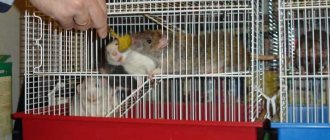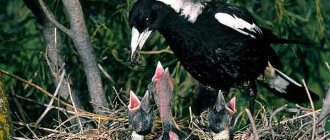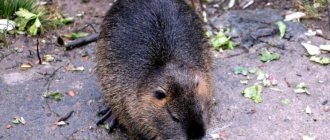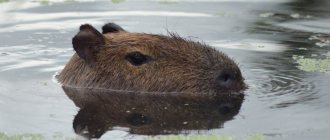- home
- Reproduction
11/09/2018 The birth of offspring is an important stage in the life of any pet. Undoubtedly, happy owners of pet hamsters are also concerned about the issues of pregnancy and childbirth of pets. Every owner of a cute pet fluffy needs to carefully prepare - study the question of how hamsters give birth, learn everything about the course of pregnancy, childbirth and postpartum care for the female.
Important nuances of hamster pregnancy
Sometimes owners find out that the pet was pregnant only during childbirth. But some animal lovers specifically purchase a pair of rodents of different sexes for breeding purposes.
Unexpected birth
If a hamster gives birth, all other rodents must be removed from the cage immediately.
Over the next 2 weeks, interference in the life of the cubs, penetration into the cage should be minimal.
Refuse cleaning and do not touch newborns. The appearance of foreign odors will frighten the female and may lead her to decide to eat the hamsters.
Planned replenishment
Take care of proper nutrition for the pregnant woman. Her diet includes more protein foods, fruits, vegetables, and also increases the amount of food and liquid due to increased energy costs. It is necessary to regularly change the water in the drinking bowl. It is better to use spring or bottled water, since tap liquid contains a lot of bleach that is harmful to rodents.
The partner and other relatives should be moved to another cage. Neighbors can disturb a pregnant woman and create stress, so before giving birth and during the first weeks after the birth of the cubs, it is better for the female to remain alone.
Complications during childbirth
In most cases, childbirth is quite simple. Complications occur in rare cases, but they can threaten the lives of babies and mothers. Therefore, the owner of rodents must not only be able to understand that the hamster is giving birth, but also be able to provide qualified assistance as soon as possible.
The majority of complications are associated with toxicosis during pregnancy. If such deviations are present, veterinarians definitely recommend euthanizing the rodent, since there is practically no chance of saving the life of the female and the hamsters. During childbirth, the following complications occur:
- Perhaps the most common complication is the fetus getting stuck in the birth canal. This can happen during a low-fertility pregnancy, when the baby is alone and too large. Or during the first pregnancy of an already middle-aged female. Hamsters stuck in the birth canal are usually born weak or dead. A characteristic sign of such a complication is that the female tenses and pushes for about 15 minutes, but the babies are not born. To save the pet, the owner needs to urgently call a veterinarian.
- Another common complication is the birth of babies forward backwards. During the normal course of labor, hamsters walk head first. Such a deviation usually does not affect the course of labor, however, the offspring may die.
- Intrauterine fetal death poses a particular danger to the female. This can happen due to poor nutrition, lack of vitamins and minerals by the female, and infectious diseases. If help is not provided in a timely manner, the animal will certainly die.
Frequent childbirth does not have the best effect on the health of Djungarians. Therefore, to avoid complications, it is recommended to maintain sufficient intervals between births.
Preparing for an addition
A pregnant female needs:
- Peace. The male should be transplanted into a separate cage no later than a week before the expected birth. During pregnancy, owners should approach the hamster less often and approach the cage only when necessary.
- Changing your diet. You will have to increase the amount of protein, add seeds, vegetables, fruits. The portion size will become larger.
- Cleanliness. You should clean up about a week before giving birth. Add 2-3 times more sawdust. They cannot be changed in the first weeks of the cubs' life.
- Free space. The attractions are being removed; in the near future they will only disturb the animals. It is better to leave the house so that the hamster can hide supplies there.
- Paper napkins or soft toilet paper for the nest. Sawdust is too hard and prickly for children. It is better to provide your hamster with softer material to build on.
How to keep a couple before mating: together or in different cages
Hamsters of this species reproduce well, and in captivity they are able to do this throughout the year. However, for this process they need to create certain conditions. So, before mating, it is better to keep the female and male in different cages, since they can show aggression towards each other - they will fight for territory. They need to be combined in one cage only for the duration of mating.
Note that peaceful coexistence of a boy and a girl in the same room is possible, but this is quite rare. If you do not have the opportunity to buy another cage, then you can place the female with the male for a while. Who knows, what if your couple will be on the list of those rare ones who live in peace and harmony. If the experiment fails, then it will still be necessary to decide to purchase a new cell. It is unlikely that you will like to put up with scratches and scraps of torn fur.
Read on for tips on choosing a cage and ball for your hamster.
You can avoid conflicts if you buy a girl and a boy at the same time and at the same time place them in a new cage. In this case, one male can even get along with several females. You should avoid placing a younger female with a male who has already been living with you for some time. In this case, war cannot be avoided.
Did you know? Experienced breeders have noticed that in a territorial war between males and females, the latter almost always win, and the males are inferior to them.
Conditions of detention
Proper maintenance will affect the future health of the animals.
Improvement of the cell
When arranging the cage, consider the following aspects:
- Litter. Avoid using patches made of artificial fabric or cotton wool. Newborns may suffocate if exposed to such materials.
- Special security. Make sure that babies cannot get out of the cage on their own. If this does happen, do not pick them up to return them to the house. Better use a spoon.
- Avoid tiers. Select cages with a small distance between the bars so that the baby cannot fall out.
- Drinking bowl. If there is water in an open container, the hamsters may drown. It is better to install a container with a spout through which the animals can independently extract liquid when they grow up a little.
- Calm. The house should be located in a place away from sources of direct bright light. It is better to put the cage in a room inaccessible to children so that noise and constant attention do not disturb the female.
Basic principles of care
More often you have to take care not of newborns, but of their mother. If the hamster has not abandoned the cubs, it is better not to touch the offspring until they grow up. The person will be required to maintain a constant temperature in the room where the cage is located.
. The optimal range is +21…+25°C.
It is better to place food next to the cage so that a hungry female can independently get food through the bars.
Dzungariki
Don't bother the hamster. Stress and nervous tension are deadly for newborn animals.
Syrian hamsters
For this species, the rules of care in the first days of life are the same as for jungarians.
How are hamsters born?
These furry animals are distinguished by very fast births. During the birth process, it can be noted that the expectant mother takes a sitting position and twists during contractions. Females help themselves during childbirth by extracting the fetus using their teeth.
The time between the birth of babies is very short and does not take more than two minutes. During the entire period of labor, the female gnaws through the membranes of the fruit so that the newborn baby has the opportunity to breathe, then she gnaws the umbilical cord and cleans the baby. After this, the hamster eats the placenta and amniotic sac.
Signs of impending labor:
- the female becomes slow, her activity decreases;
- there is a loss or decrease in appetite;
- the birth canal opens.
It is important to know that the average pregnancy of hamsters lasts about 20 days , this time may vary slightly depending on the type of rodent and the conditions under which it is kept.
Features of cultivation
Follow a number of rules to avoid harming small hamsters. Some of the litter may die even with proper care. This phenomenon is considered normal: only weak, sick individuals die.
Development of small pets
Hamsters grow and develop quickly. Already by the 2nd day of life, the skin turns pink, then darker spots appear, the color of which depends on the color of the breed. By the first week of life, reddish, gray or black fluff appears. After 1 month, the cubs will become completely independent.
Time to hold newborns
Wait until the hamster stops fiercely protecting the offspring and worrying when the owners approach. Most often, from the 15th day of life of the cubs, the mothers stop taking care of them and allow a person to touch the young animals. At an earlier age, babies can only be held if necessary. A hamster, sensing an unfamiliar smell, may abandon its newborns or kill them.
Consider the mother's temperament. If before pregnancy the female was tame and willingly contacted people, she will allow the babies to be touched earlier. In situations where the hamster was afraid of a person or showed aggression, it is better to wait longer.
Separating cubs from mother
Hamsters are ready to move into a separate cage from 3-4 weeks. Each child will have to choose a separate home. Hamsters compete for territory, they can fight, and bite each other in the fight. In addition, females are characterized by early puberty. If they live with their brothers, they can easily become pregnant.
Finding owners for rodents
You can give cubs to a new family from 4-6 weeks of life.
During this period, their diet no longer differs from the menu of adult animals.
Hamsters are allowed to be picked up, taught various tricks, and attractions installed in their cages.
New owners should be given recommendations on how to care for their pets. It is advised to share with them sawdust from the bedding in the hamster's cage. This way, in a new place, the cub will worry less and adapt faster.
You can look for new owners among friends or on special forums on the Internet. Periodically take an interest in the lives of the kids. Don't give them to people who are not ready to take responsibility for someone else's life. If a potential buyer seems unreliable, it is better to refuse him.
When the hamster is already 4 to 6 weeks old, it can be given into new hands.
Results
As you can see, giving birth to a hamster is a process that requires a lot of responsibility and care on your part if you want all the newborns to survive. In order for your pet’s birth to be successful, you must carefully monitor the maintenance and nutrition of the pregnant hamster, protect the female from unnecessary stress, and if complications arise, immediately contact a specialist.
Did you like the article? Share with friends: [supsystic-social-sharing id=”1"]
- Related Posts
- Reproduction of hamsters, what you need to know about pair selection
- Hamster pregnancy
- Hamsters mating
« Previous entry
Abandoned hamsters
If the mother abandoned the newborns, the owner will have to raise the babies himself.
Taming
In cases where the owner fed the babies on their own, they immediately grow up tame. Hamsters fed by their mother are allowed to be picked up only after 15 days, when the female stops worrying about protecting the offspring. You will have to be careful so that the animal does not fall, since a blow can lead to death. You shouldn’t squeeze babies either; their fragile bones are easy to break.
Self-feeding
If the hamster dies in childbirth or refuses to feed the cubs, the owners can place the young animals with another nurse. First, you should roll the babies in the filler from the corner where the female goes to the toilet. This way the smell of the adoptive mother will remain on the hamsters, after which she will be able to accept the cubs. If this is not possible, you will have to give milk yourself. Newborns need food every hour, so you will have to get up often during the night.
Buy a hamster milk replacer from a pet store. Dilute the mixture, strictly following the algorithm from the instructions. The liquid should be warm. Pour the mixture into a pipette or syringe without a needle. Then place the hamster in your palm and squeeze a drop of liquid onto your finger. Bring it to the rodent's nose so that it licks the food offered. Be careful to prevent the baby from choking.
After the first week, increase the interval between feedings to 2-3 hours. Gradually introduce peeled seeds and vegetables into the animals’ diet. When the eyes open, leave 2-3 additional feedings from a pipette per day. By the age of one month, hamsters will begin to feed on their own.
The owner will only have to adjust the position of the spout at the drinking bowl so that the cubs can reach it.
In order for milk to be better absorbed, it is recommended to lightly massage the newborn’s tummy in a circular motion for 2 minutes after feeding.
Artificial formulas do not contain the antibodies present in mother's milk and provide less benefit to the offspring. Because of this, the mortality rate among human-fed rodents is higher. Often, young animals deprived of mother's milk die within the first 2 weeks. As they grow older, the risk of formula-fed babies dying at an early age decreases.
Rodent nutrition
To get healthy and strong offspring, you need to properly feed the breeding hamsters before mating. Also, the quality of nutrition of a pregnant female determines whether the babies will be healthy or not. Therefore, carefully choose what to feed your pets.
Individuals should be well-fed, but not fat. Therefore, you should not abuse foods that contain fat and carbohydrates. Give preference to vitamin comas.
20-25 days before the planned mating, inspect the breeding rodents. For those that are underweight, supplement your diet with nutritious food. For those pets that have become obese, switch them to a light diet and increase physical activity (let them go for walks more often, put more toys designed for active recreation in the cage).
The daily diet of hamsters preparing for mating is as follows: 10 g of vegetables, 5 g of hay, 10 g of cereals (barley, oats, wheat), 1 g of tomato juice, 5 g of corn, 0.05 g of dry yeast.
Reasons why a female may eat her children
Eating one's own offspring is possible for several reasons. Most often, females destroy their cubs due to:
- Stress. The hamster may become nervous if other animals or people enter the cage in the first weeks after giving birth.
- Presence of pathologies in the baby. In nature, mothers often eat sick or weak newborns whose chances of survival are low. This solution allows the female to replenish the supply of protein necessary for milk production. In addition, bacteria that are dangerous to other newborns will not begin to multiply on the body of the deceased cub.
- Too many babies. The female is not able to feed everyone, so she eats several to increase the others’ chances of survival.
Actions at birth
Newborn hamsters do not have fur, so they may have problems with thermoregulation. The hamster takes care of them at this time, so the owner must provide her with this opportunity. In order for the new mother to have the opportunity to build a nest, it is necessary to put materials in the cage, such as paper towels or napkins. It is advisable that the temperature in the house be 21–25 degrees.
Since a hamster is a wild animal, the female does not require human assistance during childbirth; basically, everything goes smoothly and in a short period of time.
But if you see that the hamster cannot cope on her own, for example, when there are too many fruits, you can provide her with all possible help.
You need to take a paper towel and wrap your newborn baby in it, carefully remove the mucus and membranes of the fetus. Then a gentle massage is performed and the umbilical cord is cut. It should be cut off slightly away from the abdomen. Then you need to place the baby with the others, mixing him with other babies.
Sometimes it happens that a hamster eats its offspring after giving birth; in this case, you cannot interfere; the only help is to offer the female food rich in protein. This way it will be possible to save some newborns.
It is very important that the female feeds the offspring. It must be remembered that childbirth is a complex and exhausting process, so you need to give mommy the opportunity to rest for at least four hours. If all is well, the female will allow the babies to approach her nipples within half an hour. If she does not do this and does not show care for the offspring at all, it is recommended to isolate her with the brood to prevent her from escaping.
Why do little hamsters die?
There are several possible causes of death:
- The mother refused to feed the cubs. If the female moves to the opposite end of the cage, you can place her with the offspring on the first day. If the instinct does not manifest itself within 24 hours, it is better to find another provider or give milk to the newborns yourself.
- Congenital injuries.
- Diseases. Most often, cubs die due to milk fever. The pathogen is transmitted through mother's milk. Hamsters become lethargic and have bloating. With timely treatment, young animals can be saved.
- Incorrectly selected diet for the female. A lack of protein will result in decreased milk production. The female can independently destroy the cubs.
Timely measures can often save newborns. However, in some situations, humans are unable to help hamsters.
Read also
The condition of the dog before and during birth
Condition of the dog before and during labor Immediately before the onset of labor, the dog seeks solitude, scratches and digs in the litter, trying to make a nest for itself. She breathes frequently and heavily, lies without getting up, refuses food, is nervous, her body muscles tremble finely and manifests
Condition of the dog during childbirth
Condition of the dog during labor Immediately before the onset of labor, the dog seeks privacy, scratches and digs in the litter, trying to make a nest for itself. She breathes frequently and heavily, lies without getting up, refuses food, is nervous, her body muscles tremble finely and manifests
Complications during pregnancy and childbirth
Complications during pregnancy and childbirth Sometimes pregnancy and childbirth in dogs are accompanied by complications caused by metabolic disorders, pathology of internal organs, and improper care of the animal. False pregnancy can occur after the sexual cycle, not
Complications during childbirth
Complications during childbirth Most hamsters give birth easily and smoothly, but in some cases complications may arise that threaten the lives of the mother and babies. Therefore, it is important for every hamster breeder to be able to not only recognize birth complications, but also
Postpartum complications
Postpartum complications As soon as the female gives birth to her babies, she should not be disturbed for 2 weeks, because she can eat her babies. In general, the problem of cannibalism is very relevant for hamsters. Many females eat part of what they produce
Complications during pregnancy and childbirth
Complications during pregnancy and childbirth Often, pregnancy and then the birth of dogs are accompanied by various complications caused mainly by metabolic disorders, pathology of internal organs or improper care of the animal. False pregnancy
Complications during pregnancy and childbirth
Complications during pregnancy and childbirth Sometimes pregnancy and childbirth in dogs are accompanied by complications caused by metabolic disorders, pathology of internal organs, and improper care of the animal. False pregnancy can occur after the sexual cycle, not
Complications during childbirth
Complications during childbirth Most guinea pigs give birth easily and smoothly, but in some cases, complications may arise that threaten the lives of the mother and cubs. Therefore, it is important for every guinea pig breeder to be able to not only recognize the generic
Postpartum complications
Postpartum complications It happens that immediately after giving birth, a pig refuses to feed her babies. Most often, this complication is observed in primiparous females who have not yet gotten used to the role of mother. For 5–8 hours, the owner need not worry, because...
Complications with injections
Complications during injections: Needle fracture. A piece of the needle may remain in the tissues. This happens if the dog suddenly and sharply jerks its paw and the needle breaks at the base. If the tip of the needle protrudes from the tissue, you must quickly remove it with tweezers or your hands. If the needle goes into the muscle,
Complications during childbirth
Complications during childbirth In most ornamental mice, childbirth proceeds easily and smoothly, but in some cases complications may arise that threaten the lives of the female and cubs. Therefore, it is important for every rodent breeder to be able to not only recognize generic










